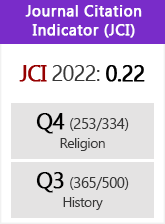Ḥattā a lo largo de los siglos: origen e historia de esta partícula en árabe clásico
DOI:
https://doi.org/10.3989/alqantara.2018.015Palabras clave:
gramaticalización, ḥattā, preposiciones, lingüística de corpus, lingüística cognitiva, árabe clásicoResumen
Los objetivos principales de este trabajo son, por una parte, plantear una propuesta metodológica para el estudio del cambio lingüístico en árabe clásico y, por otra, explorar las particularidades de los procesos de gramaticalización y el cambio lingüístico en esta lengua semítica. Para ello, hemos analizado los procesos de cambio y gramaticalización experimentados por la partícula ḥattā (‘hasta’, ‘incluso’) en árabe clásico desde el siglo VII hasta el XX. Se han analizado 731 ejemplos de ḥattā extraídos de uno de los más completos corpus históricos del árabe, el HADC, todavía inédito. El estudio ha tenido en cuenta 30 variables diferentes que se han recogido en fichas recopiladas en una base de datos relacional. Los resultados se han organizado en un esquema conceptual que presenta la vinculación semántica de cada uno de los cinco valores de ḥattā así como las trayectorias evolutivas de esta partícula en árabe clásico. Las conclusiones más relevantes son que, por descontado, sí hay cambio lingüístico en árabe clásico, si bien sus trayectorias evolutivas se ven constreñidas tanto por la presión de la norma coránica como por su naturaleza de lengua esencialmente escrita. Los resultados también revelan que existe una marcada estratificación, persistencia y divergencia en los procesos y apuntan, a su vez, la relevancia de incluir variables como el origen del autor o los tipos de texto cuando se analiza el cambio lingüístico.
Descargas
Citas
Al-Jallad, Ahmad, "The Etymology of Ḥattā", in nehmé and Al-Jallad (eds.), To the Madbar and Back Again. Studies in the languages, archaeology, and cultures of Arabia dedicated to Michael C.A. Macdonald, Leiden, Brill, 2018. https://doi.org/10.1163/9789004357617_018
Al-Jallad, Ahmad. An outline of the grammar of the Safaitic inscriptions, Leiden, Brill, 2015. https://doi.org/10.1163/9789004289826
Al-Said, Almoataz B., A Corpus-based Historical Arabic Dictionary: Linguistic & Computational processing, Phd dissertation, Cairo University, 2011.
Ali, Abdullah Yusuf, The Holy Quran: English Translation and Commentary, Ware, Wordsworth Editions, 1934 (2001).
Arberry, Arthur John, The Koran Interpreted: A Translation, new York, Touchstone, 1955 (1996).
Bisang, Walter, "Grammaticalization without coevolution of form and meaning: The case of tense-aspect-modality in East and mainland Southeast Asia", in W. Bisang, n. P. himmelmann, and B. Wiemer (eds.), What makes Grammaticalization?: A Look from its Fringes and its Components, Berlin, Walter de Gruyter, 2004, pp. 109-138.
Bybee, Joan L., "Cognitive processes in grammaticalization", in Michael Tomasello (ed.), The new psychology of language: Cognitive and functional approaches to language structure, hillsdale, nJ, Lawrence Erlbaum, 2003, pp.145-167.
Chejne, Anwar G., The Arabic language: Its role in history, Minnesota, University of Minnesota Press, 1969.
Corriente, Federico, Christophe Pereira, and Ángeles vicente, (eds.), Dictionnaire du faisceau dialectal arabe andalou: Perspectives phraséologiques et étymologiques, Berlin, Walter de Gruyter, 2017. https://doi.org/10.1515/9783110450194
Cuenca, Maria Josep, "La gramaticalización", in i. ibarretxe Antuñano and J. valenzuela (eds.), Lingüística cognitiva, Barcelona, Anthropos, 2012, pp. 281-334.
Diewald, Gabriele, "A model for relevant types of contexts in grammaticalization", Typological Studies in Language, 49 (2002), pp. 103-120. https://doi.org/10.1075/tsl.49.09die
Diewald, Gabriele, "Grammaticalization and pragmaticalization", in heiko narrog and Bernd heine (eds.), The Oxford Handbook of Grammaticalization, Oxford, Oxford University Press, 2011, pp. 450-461. https://doi.org/10.1093/oxfordhb/9780199586783.013.0036 PMid:22082239 PMCid:PMC3282598
Diewald, Gabriele, "Pragmaticalization (defined) as grammaticalization of discourse functions", Linguistics, 49/2, (2011), pp. 365-390. https://doi.org/10.1515/ling.2011.011
Dozy, Reinhart Pieter Anne. Supplément aux dictionnaires arabes, Leiden, Brill, vol. 1, 1881.
Esseesy, Mohssen, Grammaticalization of Arabic prepositions and subordinators: A corpus-based study, Leiden, Brill, 2010. https://doi.org/10.1163/9789004187634
Evans, nicholas and Wilkins, david, "in the mind's ear: The semantic extensions of perception verbs in Australian languages", Language, 76 (2000), pp. 546-592. https://doi.org/10.2307/417135
Ferrando, ignacio, Introducción a la historia de la lengua árabe: nuevas perspectivas, Zaragoza, Universidad de Zaragoza, 2001.
Fuentes Rodríguez, Catalina, Enlaces extraoracionales, Madrid, Ediciones Alfar, 1987.
Garachana, Mar, "Los procesos de gramaticalización", Moenia, 5 (1999), pp. l55-l72.
Grice, herbert Paul, "Logic and Conversation", in P. Cole, y J. L. Morgan (eds.), Syntax and Semantics, new York, Academic Press, 1975, pp. 41-58.
Haeri, Niloofar. Sacred language, ordinary people: Dilemmas of culture and politics in Egypt, Springer, 2003. https://doi.org/10.1057/9780230107373 PMid:12468280
Heine, Bernd, "On the role of context in grammaticalization", Typological Studies in Language, 49 (2002), pp. 83-102. https://doi.org/10.1075/tsl.49.08hei
Heine, Bernd, and Tania Kuteva. World lexicon of grammaticalization, Cambridge, Cambridge University Press, 2002. https://doi.org/10.1017/CBO9780511613463
Hopper, Paul J., "On some principles of grammaticization", in Elizabeth Closs Traugott and Bernd heine (eds.), Approaches to grammaticalization, Amsterdam, John Benjamins, vol. 1, 1991, pp. 17-35.
ibn Hišām, Ǧamāl al-dīn Abū Muḥammad 'Abdallāh b. Yūsuf b. Aḥmad b. 'Abdallāh, Muġnī al-labīb 'an kutub al-'a'ārīb, Māzin al-Mubārak and Muḥammad 'Alī Ḥamd Allāh (eds.), Beirut, dār al-Fikr, 1995.
ibn Manẓūr, Muḥammad ibn Mukarram, Lisān al-ʿarab, Beirut, dar Ṣādir, 15 vols, 1290 (1955).
Irbillī, Alī ibn Muḥammad, Kitāb Ǧawāḫir al-ʾadab fī maʿrifāt al-ʿarab, Cairo, Maṭbaʿat Wādī al-Nīl al-Miṣrīya, 1294/1877.
Kabatek, Johannes. "Tradiciones discursivas jurídicas y elaboración lingüística en la España medieval", Cahiers d'études hispaniques medievales 27/1 (2004), pp. 249-261. https://doi.org/10.3406/cehm.2004.1623
Kabatek, Johannes. "Tradiciones discursivas y cambio lingüístico." Lexis 29/2 (2005), pp.151-177.
Khan, Mohsin, The Noble Quran in the English Language, Saudi Arabia, King Fahd Printing Complex, 1996.
Lakoff, George and Johnson, Mark, Metaphors we live by, Chicago, University of Chicago Press, 1980.
Lane, Edward William, An Arabic-English Lexicon: Derived from the Best and the Most Copious Eastern Sources, London, Williams and norgate, 1865-1893.
Langer, Michael, "Conjunctions", in Kees versteegh (ed.), Encyclopedia of Arabic Language and Linguistics, Leiden, Brill, pp. 467-470.
Maldonado, Ricardo, "La gramática cognitiva", in i. ibarretxe Antuñano and J. valenzuela (eds.), Lingüística cognitiva, Barcelona, Anthropos, 2012, pp. 213-248.
Medea-García, L., and Al-Said, Almoataz, "The historical Arabic dictionary Corpus and its Suitability for a Grammaticalization Approach: A Case Study", communication presented at the V International Conference: Grammar and Corpora, Warsaw, 2014.
Medea-García, L., "Gramaticalización y cambio lingüístico en árabe. El caso de ḥattà en lengua clásica y dialectal", Phd dissertation, Barcelona, Universitat Autònoma de Barcelona, 2017, retrieved from https://www.tdx.cat/bitstream/ handle/10803/459246/lmgl1de1.pdf?sequence=1&isAllowed=y.
Melis, Chantal, Marcela Flores, and Sergio Bogard. "La historia del español. Propuesta de un tercer período evolutivo." Nueva Revista de Filología Hispánica 51/1 (2003), pp. 1-56. https://doi.org/10.24201/nrfh.v51i1.2202
Owens, Jonathan. A linguistic history of Arabic, Oxford, Oxford University Press, 2006. https://doi.org/10.1093/acprof:oso/9780199290826.001.0001
Pickthall, Mohammed Marmaduke, The Meaning of the Glorious Koran, new York, Plume, 1930 (1997).
Pons Bordería, Salvador. "El siglo xx como diacronía: intuición y comprobación en el caso de 'o sea'", RILCE, 30/3 (2014), pp. 985-1016.
Rendsburg, Gary A., Aaron d. Rubin, and John huehnergard. "A proper view of Arabic, Semitic, and more", Journal of the American Oriental Society, 128/3 (2008), pp. 533-541.
Rodríguez Rosique, Susana, Pragmática y Gramática: condicionales concesivas en español, Frankfurt, Peter Lang, 2008.
Sadan, Arik, The subjunctive mood in Arabic grammatical thought, Leiden, Brill, 2012. https://doi.org/10.1163/9789004234239
Sahih international, The Quran: Arabic Text with Corresponding English Meanings, Saudi Arabia, Abul Qasim Publishing house, 1997.
Sarwar, Muhammad, The Holy Qur'an: The Arabic Text and English Translation, London, Elmhurst, 1981.
Talmy, Leonard, "Force dynamics in language and cognition", Cognitive science, 12/1, (1988), pp. 49-100. https://doi.org/10.1016/0364-0213(88)90008-0
Traugott, Elizabeth Closs and König, Ekkehard, "The semantics pragmatics of grammaticalization revisited", in Elizabeth Closs Traugott and Bernd heine (eds.), Approaches to grammaticalization, Amsterdam, John Benjamins, vol. 1, 1991, pp. 189-218.
Traugott, Elizabeth Closs, "Meaning-change in the development of grammatical markers", Language sciences, 2/1, (1980), pp. 44-61. https://doi.org/10.1016/S0388-0001(80)80004-0
Traugott, Elizabeth Closs, "On the rise of epistemic meanings in English: An example of subjectification in semantic change", Language, 65/1, (1989), pp. 31-55. https://doi.org/10.2307/414841
Traugott, Elizabeth Closs, "From less to more situated in language: the unidirectionality of semantic change", in 5th International Conference on English Historical Linguistics, Amsterdam-Philadelphia, John BenjaminsPublishing Company, 1990, pp. 497-517. https://doi.org/10.1075/cilt.65.28clo
Traugott, Elizabeth Closs, "Subjectification in grammaticalization", in dieter Stein and Susan Wright (eds.), Subjectivity and subjectivisation: Linguistic perspectives, Cambridge, Cambridge University Press, 1995, pp. 31-54. https://doi.org/10.1017/CBO9780511554469.003
Traugott, Elizabeth Closs, "Semantic change: An overview", Glot international, 2/9-10, (1996). pp. 3-7.
Traugott, Elizabeth Closs, "(inter)subjectivity and (inter)subjectification: A reassessment", in Kristin davidse, Lieven vandelanotte, and hubert Cuyckens (eds.), Subjectification,intersubjectification and grammaticalization, Berlin, Walter de Gruyter, 2010, pp. 29-71. https://doi.org/10.1515/9783110226102.1.29
Versteegh, Kees, The Arabic Language, Edinburgh, Edinburgh University Press, 2014.
Visconti, Jacqueline. "On the origins of scalar particles in italian", Journal of Historical Pragmatics, 6/2 (2005), pp. 237-261. https://doi.org/10.1075/jhp.6.2.05vis
Wright, William, A grammar of the Arabic language, new delhi, Anmol Publications, 1999 [First ed.1859-1962].
Descargas
Publicado
Cómo citar
Número
Sección
Licencia
Derechos de autor 2019 Consejo Superior de Investigaciones Científicas (CSIC)

Esta obra está bajo una licencia internacional Creative Commons Atribución 4.0.
© CSIC. Los originales publicados en las ediciones impresa y electrónica de esta Revista son propiedad del Consejo Superior de Investigaciones Científicas, siendo necesario citar la procedencia en cualquier reproducción parcial o total.Salvo indicación contraria, todos los contenidos de la edición electrónica se distribuyen bajo una licencia de uso y distribución “Creative Commons Reconocimiento 4.0 Internacional ” (CC BY 4.0). Puede consultar desde aquí la versión informativa y el texto legal de la licencia. Esta circunstancia ha de hacerse constar expresamente de esta forma cuando sea necesario.
No se autoriza el depósito en repositorios, páginas web personales o similares de cualquier otra versión distinta a la publicada por el editor.














